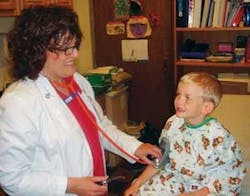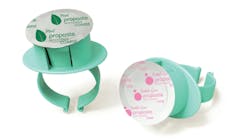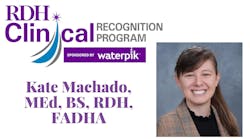Changing the way we care for kids right where we can find them ... at school
by Betsy Bray, RDH
As the school bell’s ring signals classes to begin, school-based health providers are gearing up for a day of physicals, immunizations, counseling sessions, and prophies. School-based health centers are changing the way we care for kids by delivering comprehensive care right where we can find them – at school.
School-based health care emerged in the 1970s in response to an increasing number of children and adolescents who lacked access to health care, and the care that was available did not address cultural diversity and age-sensitive information.1 Today, school-based health centers (SBHC) continue to reach students where access to services and compliance with recommended care were previously lacking. School districts all over the country have adopted this model, and the trend is growing.
Where an SBHC exists, you’ll find inappropriate use of emergency room visits declining and students seeking mental health services increasing.2 Access to services bears additional outcomes, including an increase in the management of chronic illnesses and a decrease in absenteeism.3 A study of elementary school-based health centers conducted by Montefiore Medical Center determined the school-based health care’s effects on asthma resulted in a reduction in the hospitalization rate, and these students with asthma missed three fewer days of school.4 These outcomes directly affect the cost of care, resulting in a reduction in Medicaid expenditures.5 Evidence-based data demonstrates SBHC’s success in providing access to high-quality, comprehensive care, which adds measurable value to health care today.
Although evidence to support the positive impact of school-based health care on academic outcomes is limited, no one disputes that students perform better when they show up for school healthy and ready to learn. School-based health brings services to the school, so students are absent less often and can focus on success in the classroom.
Any student enrolled in the school district may also enroll in the SBHC and utilize the services. SBHCs provide comprehensive primary health care, mental health care, and preventive oral health care. SBHC services encompass a broad range, from well-child physicals and management of chronic conditions, to placement of dental sealants and tobacco cessation programs.
Successful SBHCs build upon a collaborative relationship between the school district, school community, and the sponsoring agency. In settings where the SBHC team works cooperatively within the school community, mutual respect between the administration, staff, and the SBH team exists. SBHC community advisory boards gauge success, address current trends, and continually assess the needs of the community to ensure that an effective SBHC develops. Ideally, a shared mission promotes the health and educational success of their students.
In our region, 13 SBHCs sprawl across four rural counties and cover more than 500 square miles of mountainous terrain. Cooperstown, N.Y., hosts the heart of our operation – The Mary Imogene Bassett Hospital. Located in the birthplace of baseball, Bassett Hospital serves not only as an SBH sponsoring agency, but also as a teaching institution affiliated with Columbia University. Beyond delivering primary care, conducting research, and managing day-to-day operations, school-based health administrators at Bassett Hospital continually advocate growth opportunities and funding streams. At a time when SBHCs are closing due to funding shortages, the Bassett SBH program is thriving through the tireless efforts of a program director and manager.
On the front lines, SBH team members deliver comprehensive care to the students each day. Nurse practitioners, physicians, mental health workers (LCSW-R, LCSW, L-MSW), nurses, registered dental hygienists, and health educators comprise a school-based health team. Behind the scenes, committed support staff keep the scheduling, billing, and lab services going.
In concert with school nurses, collaborating physicians, and supervising dentists, the teams place students at the forefront of care delivery. Student-centered care empowers students to participate responsibly in their own health care. The focus is on prevention and early intervention, and our vision to empower students and their families toward lifelong wellness guides us.
Today in America, 30 percent of medical expenses relate directly to treating dental diseases.6 Each year, school-age children lose an estimated 51 million school hours to dental-related illness.7 In New York alone, 2,900 children under age 6 were treated for dental diseases in a hospital setting.8 Work is being done at the federal, state, and local levels to address early childhood caries (ECC) through maternal health education and prenatal care. However, too many kids still start school without ever having to “open wide.”
School-based oral health services are available to all pre-kindergarten to twelfth-grade students. Services include an oral health assessment, individualized oral hygiene instruction, diet analysis, dental prophylaxis, and sealant application (some settings even provide restorative care). A pain scale and a level of dental anxiety are also measured. Finally, SBHCs provide parents a recommendation outlining areas of concern and proposed preventive care.
Achieving success with our target audience can be challenging at best. Parents focus on making ends meet, and driving 30 miles or more to seek dental care is prohibitive. Sadly, preventive care often falls low on a family’s priority list. Oral health care in an SBH setting allows us to access the neediest children and assist families in need of dental care.
The Road To Success
Care management involves coordinating the recommendation for care that results in active treatment. Communicating with families to discuss their children’s dental needs can be compared to performing a prophy on a typodont vs. a human. Remember that typodont? He responded perfectly to our requests, and we manually moved his head to a perfect position for optimal instrumentation. And then came the real person, with emotions, limitations, and often an obstructed view. I once believed that when I explained a child’s needs, the parents would, of course, fix the problem. Unfortunately, lacking information is not the only variable. When interacting with families, many barriers exist. These interactions require careful footing, a solid understanding of the socioeconomic climate, and a heaping dose of empathy. Once a connection is made, progress is possible.
A third-grader was referred to the SBHC. Every tooth in Ben’s mouth had a lesion, his pain scale was eight out of 10 most days. He was struggling in the classroom and on the playground. His parents were in a custody battle, and his Medicaid had lapsed. His mother lives out of the area, and his father sleeps days and works nights. After three years, a small army advocating for Ben at school provided his dad the encouragement and help with scheduling the necessary appointments needed to relieve his son’s pain.
An 18-year-old ninth-grader presents to the clinic with full orthodontia. His arch wire is broken and poking into his cheek. He tells his story. Kevin had his braces for several years and his last adjustment was three years ago. Upon moving to another state to live with his grandmother, she offered to pay for braces. When that relationship dissolved, so did the orthodontic payments. Three years later, back with his dad, finances remain a problem. A combination of persistence, transportation arrangements, and a generous orthodontist culminated in completed treatment and Kevin’s braces came off.
A fourth-grader presents to the school nurse in pain from dental caries. Financial hardship and fear keep this little girl from health. A referral to reactivate her Medicaid takes time. While we wait, we address her fear and anxiety. Before, Sara had to be physically dragged, kicking and screaming, into the dental office. With strategies we developed together, Sara now has successful dental appointments. And she has a big smile! Is it her confidence or the absence of pain?
The unique SBHC settings allow multidisciplinary teams to gather, discuss, and promote students’ needs.
Who Foots The Bill?
Families bear no out-of-pocket cost for the care provided. To keep the operation running smoothly, SBHCs perform a delicate balancing act with available funds.
The Mary Imogene Bassett Hospital’s SBHC funding consists of:
- Insurance revenue – 50 percent
- NYS Department of Health funding – 40 percent
- In-kind support from the sponsoring agency (MIBH) – 10 percent
- Laboratory supervision, printing, pharmacy, courier …
- In-kind support from the school
- Room, heat, lights, phone, fax, and maintenance …9
Currently, more than 1,700 SBHCs cover 45 states.10 These centers depend in part on the support of the National Assembly on School-Based Health Care (NASBHC).
NASBHC is committed to promoting and supporting school-based health by advocating sustainable resources at all levels of government. Legislation is underway to authorize the first-ever federal grant program for school-based health centers. The Establishment Act (HR 4230) was introduced on Nov. 15, 2007.11
Additional funding for school-based health care will “strengthen health equity for our nation’s most disadvantaged youth and foster greater opportunities for learning readiness and academic success.” (NASBHC)
School-Based Health, easy access to quality health care for kids! To learn more about school-based health care and to take a virtual tour, visit www.nasbhc.org. In New York State, visit www.nystatesbhc.org.
About the Author
Elizabeth S. Bray, RDH, is an oral health coordinator for the Mary Imogene Bassett School-Based Health oral health program. She graduated with an associate’s degree from Onondaga Community College in 1990. Ms. Bray has a broad range of experience in the field of dental hygiene spanning eighteen years, working in a variety of settings including general dentistry and orthodontics, as well as practice development consultant and a continuing education Presenter. She resides in the upper Catskill region of New York State with her husband and two children.
References
- NASBHC. November 2007. National Assembly on School-Based Health Care. Accessed Nov. 16, 2007 at: http: //www.nasbhc.org.
- Key JD, Washington EC, Hulsey TC. Reduced emergency department utilization associated with SBHC enrollment. Journal of Adolescent Health 2002; 30:273-278. Juszczak L, Melinkovich P, Kaplan D. Use of health and mental health services by adolescents across multiple delivery sites. Journal of Adolescent Health 2003; 32S:108-118.
- Lurie N, Bauer EJ, Brady C. Asthma outcomes in an inner-city SBHC. Journal of School Health 2001; 71(9):9-16.
- Lurie N, Bauer EJ, Brady C. Asthma outcomes in an inner-city SBHC. Journal of School Health 2001; 71(9):9-16.
- Adams EK, Johnson V. An elementary SBHC: can it reduce Medicaid costs? Pediatrics April 2000; 105:4pt1:780-8.
- Jayanth Kumar. Lecture. Mary Imogene Bassett Hospital, New York. Oct. 17, 2007.
- National Maternal and Child Oral Health Resource Center. November 2007. National Maternal and Child Oral Health Resource Center. Accessed Nov. 10, 2007, at: http://www.mchoralhealth.org/.
- Jayanth Kumar. Lecture. Mary Imogene Bassett Hospital, New York. Oct. 17, 2007.
- Christopher Kjolhede, Jane Hamilton. Lecture. Mary Imogene Bassett Hospital, New York. March 29, 2006.
- NASBHC. November 2007. National Assembly on School-Based Health Care. Accessed Nov. 16, 2007, at: http: //www.nasbhc.org.
- NASBHC. November 2007. National Assembly on School-Based Health Care. Accessed Nov. 16, 2007, at: http: //www.nasbhc.org.










